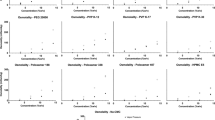Abstract
Purpose. The purpose of this study was to determine the osmolality of sulfobutylether (SBE) and hydroxypropyl (HP) derivatives of cyclodextrins (CDs) via vapor pressure osmometry (VPO) and freezing point depression (FPD). (SBE) and HP-CDs are efficient excipients capable of solubilizing and stabilizing poorly water-soluble drugs in parenteral formulations. (SBE)-CDs have also been used as solubility enhancers and osmotic agents for the sustained release of poorly water-soluble drugs from osmotic pump tablets. The knowledge of the CD's osmolality in solution or inside such tablets would allow one to further characterize the release mechanisms.
Methods. Experiments were conducted at 37°C with eight types of HP and (SBE)-CDs. The aqueous solutions ranged from 0.005-0.350 mol l− 1. Methods were developed to allow the measurement of high osmolalities using a vapor pressure osmometer or a differential scanning calorimeter.
Results. The osmolality calculations from the VPO and FPD measurements correlated well. The osmolality of (SBE)-CDs was significantly higher than the osmolality of HP-CDs and increased with the total degree of substitution (TDS). All CDs showed deviations from ideality at high concentrations.
Conclusions. Empirical correlations of osmolality with concentration and TDS allowed the prediction of osmolality over a wide concentration range. This study also gave some useful insights into the behavior of CD derivatives in solution.
Similar content being viewed by others
REFERENCES
T. Loftsson and M. E. Brewster. Pharmaceutical applications of cyclodextrins. 1. Drug solubilization and stabilization. J. Pharm. Sci. 85:1017-1025 (1996).
D. O. Thompson. Cyclodextrins: Enabling excipients. Their present and future use in pharmaceuticals. Crit. Rev. Ther. Drug Carrier Syst. 14:1-104 (1997).
J. Blanchard and S. Proniuk. Some important considerations in the use of cyclodextrins. Pharm. Res. 16:1796-1798 (1999).
R. A. Rajewski and V. J. Stella. Pharmaceutical applications of cyclodextrins. 2. In vivo drug delivery. J. Pharm. Sci. 85:1142-1169 (1996).
A. N. Martin. Solutions of nonelectrolytes, solutions of electrolytes. In Physical Pharmacy (Physical Principles in the Pharmaceutical Sciences), 4th ed., Lea & Febiger, Philadelphia, 1993 pp. 101-142.
K. Okimoto, M. Miyake, N. Ohnishi, R. A. Rajewski, V. J. Stella, T. Irie, and K. Uekama. Design and evaluation of an osmotic pump tablet (OPT) for prednisolone, a poorly water soluble drug, using (SBE)7M-β-CD. J. Pharm. Sci. 15:1562-1568 (1998).
K. Okimoto, R. A. Rajewski, and V. J. Stella. Release of testosterone from an osmotic pump tablet utilizing (SBE)7M-β-cyclodextrin as both a solubilizing and an osmotic pump agent. J. Control Release 58:29-38 (1999).
F. Theeuwes. Elementary osmotic pump. J. Pharm. Sci. 64:1987-1991 (1975).
G. M. Zentner, G. S. Rork, and K. J. Himmelstein. Osmotic flow through controlled porosity films: An approach to delivery of water soluble compounds. J. Control. Release 2:217-229 (1985).
E. A. Zannou. A mechanistic study of drug release from cyclodextrin-based controlled porosity osmotic pump tablets, Ph.D. thesis, The University of Kansas, Lawrence, KA, 2000.
M. P. Tombs and A. R. Peacocke. The Osmotic Pressure of Biological Macromolecules, Oxford University Press, London, 1974.
W. H. Streng, H. E. Huber, and J. T. Carstensen: Relationship between osmolality and osmolarity. J. Pharm. Sci. 67:384-386 (1978).
R. A. Robinson and R. H. Stokes. Electrolyte solutions (the measurement and interpretation of conductance, chemical potential and diffusion). In Solutions of Simple Electrolytes, 2nd ed., Academic Press, New York, 1959.
M. Nagvekar, F. Tihminlioglu, and R. P. Danner. Colligative properties of polyelectrolyte solutions. Fluid Phase Equilibria 145:15-41 (1998).
A. V. Wolf, M. G. Brown, and P. G. Prentiss. Concentrative properties of aqueous solutions: Conversion tables. In Handbook of Chemistry and Physics, 55th Ed., CRC Press, Cleveland, OH, 1975 pp. D-194-241.
E. L. Charsley. Calibration of differential thermal analysis equipment: The ICTA temperature standards. Anal. Proc. 17:223-226 (1980).
H. E. Bair. Glass transition measurements by DSC. ASTM STP 1249:50-74 (1994).
D. Q. Ma, R. A. Rajewski, and V. J. Stella. Thermal properties and processing of (sulfobutylether)7m-β-cyclodextrin as a freeze-drying excipient in pharmaceutical formulations. S.T.P. Pharm. Sci. 9:261-266 (1999).
J. L. Fried. The solid-state properties of polymers. In Polymer Science and Technology, Prentice Hall PTR, Englewood Cliffs, NJ, 1995 pp. 132-181.
J. Szejtli. Introduction and general overview of cyclodextrin chemistry. Chem. Rev. 98:1743-1753 (1998).
V. Zia. Thermodynamics and mechanisms of inclusion complexation: Specific comparison of sulfoalkyl ether beta-cyclodextrins to hydroxypropyl beta-cyclodextrins, Ph.D. thesis, The University of Kansas, Lawrence, KA, 1998.
T. X. Viegas and R. L. Henry. Osmotic behavior of poloxamer 407 and other non-ionic surfactants in aqueous solution. Int. J. Pharm. 160:157-162 (1998).
J. F. Thain. Principles of osmotic phenomena. Royal Inst. Chem. Monographs Teachers 13:1-69 (1967).
C. Tanford. Thermodynamics. In Physical Chemistry of Macromolecules, John Wiley & Sons, New York, 1961 pp. 180-274.
B. L. Neal, D. Asthagiri, and A. M. Lenhoff. Molecular origins of osmotic second virial coefficients of proteins. Biophys. J. 75: 2469-2477 (1998).
H. E. Huber, W. H. Streng, and H. G. H. Tan. Osmolality of parenteral solutions. J. Pharm. Sci. 68:1028-1032 (1979).
Author information
Authors and Affiliations
Rights and permissions
About this article
Cite this article
Zannou, E.A., Streng, W.H. & Stella, V.J. Osmotic Properties of Sulfobutylether and Hydroxypropyl Cyclodextrins. Pharm Res 18, 1226–1231 (2001). https://doi.org/10.1023/A:1010947631380
Issue Date:
DOI: https://doi.org/10.1023/A:1010947631380




